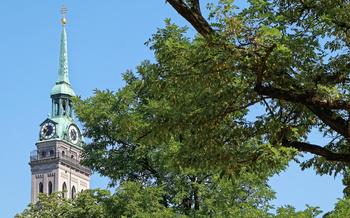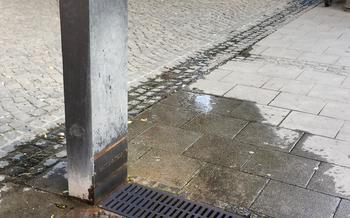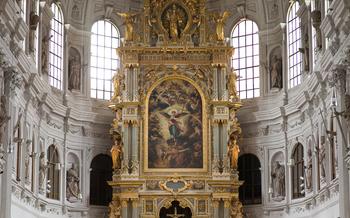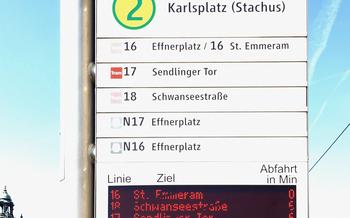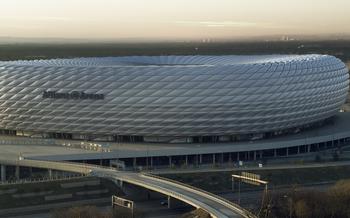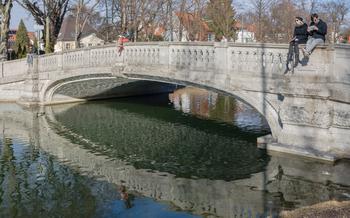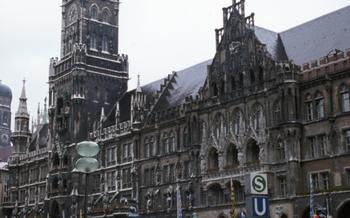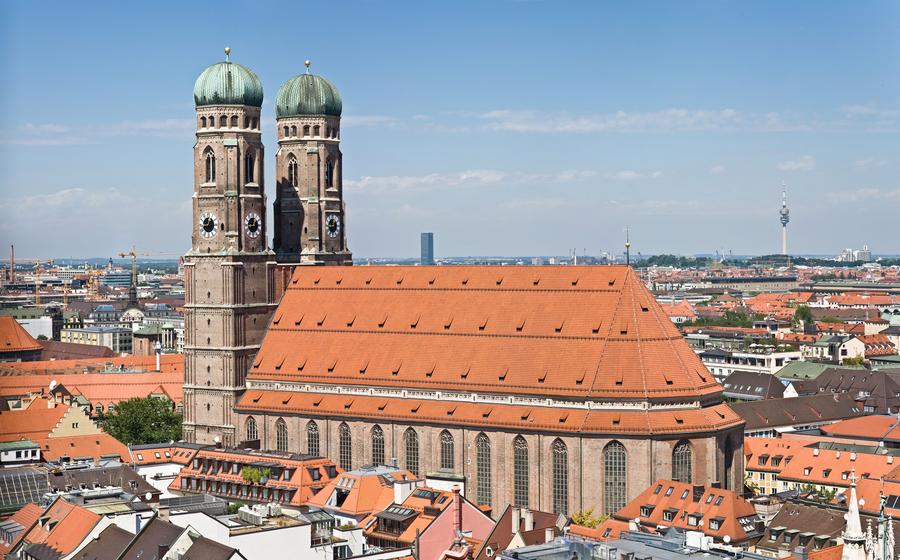
Church of Our Lady (Frauenkirche)
- The Church of Our Lady (Frauenkirche)
- Location and Accessibility
- History and Construction
- Architectural Highlights
- Interior Design
- Historical Significance
- Cultural Importance
- Insider Tips:
- Tower Climb
- Historical Events
- Religious Significance
- Nearby Attractions
- Insider Tip: Hidden Details
The Church of Our Lady (Frauenkirche)
The Church of Our Lady, also known as Frauenkirche, stands as a testament to Munich's rich history and cultural significance. Its imposing presence in the heart of the city reflects its role as a religious center and a symbol of resilience. Completed in the 15th century, this Gothic masterpiece boasts intricate brickwork, soaring twin towers, and a harmonious blend of architectural styles. Frauenkirche has become a must-see attraction for visitors seeking to delve into Munich's cultural heritage and admire its architectural splendor.
Location and Accessibility
The Church of Our Lady is strategically situated in the heart of Munich, facing the bustling Marienplatz square. This central location makes it easily accessible by various means of transportation. The Marienplatz U-Bahn station, served by multiple lines, is just a short walk away, providing a convenient connection to the city's extensive public transportation network. For those who prefer to explore on foot, the church is within easy walking distance from many hotels, restaurants, and attractions in the city center. Whether you choose to arrive by public transportation or on foot, the Church of Our Lady's central location ensures a seamless and enjoyable visit.
History and Construction
The Church of Our Lady, also known as Frauenkirche, stands as a testament to the architectural prowess of the 15th century. Its Gothic roots are evident in its soaring spires, intricate details, and vaulted ceilings. Constructed primarily of red brick, the church's twin towers, each reaching a height of 99 meters, dominate the Munich skyline and serve as iconic landmarks of the city.
The foundation stone for Frauenkirche was laid in 1468, and its construction spanned four decades, completed in 149The church's design is attributed to Jörg von Halsbach, a renowned architect of the time, who drew inspiration from the Late Gothic style prevalent in Southern Germany. The church's exterior is characterized by its intricate brickwork, featuring herringbone and diamond patterns that add a unique texture to its facade.
Despite its grand size, Frauenkirche was built remarkably quickly for its time, a testament to the skill and dedication of the medieval builders. The church's construction was funded by the wealthy citizens of Munich, who sought to create a magnificent house of worship that would reflect the city's growing prosperity and religious devotion.
Architectural Highlights
The Frauenkirche's architectural prowess is evident in its intricate details, which showcase the skill and artistry of the 15th-century builders. The vaulted ceilings soar overhead, creating a sense of grandeur and spaciousness. The interior is adorned with magnificent stained glass windows, which bathe the church in a kaleidoscope of colors, especially during the golden hours of sunrise and sunset. Ascending the tower, visitors are rewarded with breathtaking panoramic views of Munich and the surrounding Bavarian countryside, stretching for miles in every direction.
Interior Design
While Frauenkirche's exterior is breathtaking, its interior is equally impressive. Baroque elements blend seamlessly with Gothic architecture, creating a visually stunning space. Admire the intricate details of the vaulted ceilings, supported by slender pillars. The stained glass windows, with their vibrant colors and intricate designs, cast a warm glow on the interior. The high altar, a masterpiece of Baroque art, is a focal point of the church. It features intricate carvings, sculptures, and paintings that depict scenes from the life of Christ. Other notable artworks include the tomb of Emperor Ludwig IV, the Pietà by Hans Multscher, and the Madonna of Munich, a wooden sculpture from the 15th century.
Historical Significance
The Frauenkirche holds immense historical significance as a religious and cultural landmark in Munich. It has served as a central place of worship for centuries and played a crucial role in shaping the city's identity. Throughout its existence, the church has witnessed significant historical events, including the Reformation and the Thirty Years' War. Despite facing severe damage during World War II, the Frauenkirche miraculously survived the bombings, standing as a testament to its resilience and enduring spirit. Today, it remains a symbol of Munich's rich history, cultural heritage, and unwavering faith.
Cultural Importance
The Frauenkirche is not just a religious landmark but also a hub of cultural significance. Over the centuries, it has hosted numerous concerts, events, and celebrations, solidifying its status as a cultural center. The church's acoustics are renowned for their clarity, making it an ideal venue for classical music performances and organ concerts. The Frauenkirche is also a popular destination for weddings and other special occasions, with its stunning interior providing a majestic backdrop for life's momentous events.
Beyond its musical and ceremonial significance, the Frauenkirche is a pilgrimage site for many Catholics worldwide. The church is dedicated to the Virgin Mary, and pilgrims flock to the shrine to pay homage and seek blessings. The Frauenkirche is deeply embedded in local traditions and customs, and its annual festivals and processions draw thousands of participants and spectators. These events showcase the vibrant religious and cultural heritage of Munich and Bavaria, attracting both locals and visitors alike.
Insider Tips:
Best Time to Visit:
- Avoid weekends and public holidays to escape the crowds, especially during the summer months.
- For a serene experience, visit early in the morning or late in the afternoon when the church is less crowded.
Avoid the Crowds:
- If you're seeking a quieter atmosphere, consider visiting during the off-season (November to March) when tourist numbers are lower.
Photography Spots:
- Capture stunning exterior shots from the nearby Marienplatz, showcasing the church's grandeur against the backdrop of the Neues Rathaus.
Nearby Attractions:
- Combine your visit with a stroll through the bustling Viktualienmarkt, a vibrant food market offering fresh produce, local delicacies, and culinary delights.
- Afterwards, savor a traditional Bavarian meal and a stein of beer at the world-famous Hofbräuhaus, just a short walk from the church.
Tower Climb
Ascend the winding staircase to the top of the Frauenkirche's south tower for breathtaking panoramic views of Munich. The 365 steps may seem daunting, but the reward is worth the effort. From the observation deck, you'll be treated to a bird's-eye perspective of the city's iconic landmarks, including the Neues Rathaus, the Viktualienmarkt, and the Alps on a clear day.
The tower climb is open to the public during specific hours, and a small admission fee is required. Be sure to check the website for updated information on hours and fees. For safety reasons, the climb is not recommended for individuals with heart conditions or mobility issues.
While climbing the tower, take a moment to admire the intricate details of the architecture and the stunning stained-glass windows. The tower's exterior is adorned with intricate carvings and gargoyles, adding a touch of whimsy to the Gothic masterpiece.
Historical Events
The Church of Our Lady has played a significant role in several historical events that have shaped Munich's identity. During World War II, the church suffered extensive damage from Allied bombings, leaving only the outer walls and towers standing. The reconstruction efforts that followed were a symbol of resilience and determination for the city, with the church being rebuilt to its former glory.
Today, the Frauenkirche stands as a testament to the city's rich history and enduring spirit. It serves as a reminder of the devastating effects of war and the importance of preserving cultural heritage. The meticulous reconstruction efforts have ensured that this architectural masterpiece continues to be a source of pride and inspiration for Munich and its visitors.
Religious Significance
As a Catholic church, the Frauenkirche holds immense religious significance for the people of Munich and beyond. It is dedicated to the Blessed Virgin Mary, who is revered as the patron saint of the city. Throughout history, the church has been a popular pilgrimage destination for Catholics seeking spiritual guidance and comfort. The annual "Frauenfest" (Festival of Our Lady) is a major religious event that attracts thousands of pilgrims to the church each year. During this festival, special masses, processions, and celebrations are held to honor the Virgin Mary.
Nearby Attractions
The Church of Our Lady is strategically situated in the heart of Munich, surrounded by a plethora of captivating attractions that further enhance its charm and allure. A short stroll from the church, you will find yourself in the vibrant Marienplatz, the central square of Munich that exudes a unique blend of history, culture, and local life. Here, you can marvel at the majestic Neues Rathaus (New Town Hall), with its intricate Gothic architecture and world-famous Glockenspiel (clock tower) that performs a captivating show of dancing figures.
Just a stone's throw away, the Viktualienmarkt beckons with its vibrant colors and aromas. This bustling market square is a paradise for food enthusiasts, offering fresh produce, artisanal cheeses, exotic spices, and delectable delicacies from around the world. Indulge in a culinary adventure as you sample local specialties and soak up the lively atmosphere.
For those seeking a taste of Munich's renowned beer culture, the Hofbräuhaus is an absolute must-visit. This legendary tavern has been serving up frothy steins of beer and traditional Bavarian fare since 158Experience the convivial ambiance and camaraderie as you raise a glass alongside locals and fellow travelers, immersing yourself in the city's rich brewing heritage.
Insider Tip: Hidden Details
Beyond its grand facade and iconic twin towers, the Church of Our Lady (Frauenkirche) conceals a wealth of hidden details that invite exploration. Look for the intricate astronomical clock, a marvel of medieval engineering, which displays the time, date, and astrological information. Discover the whimsical gargoyles and sculptures that adorn the exterior, each with its own unique story to tell. Explore the secret passageways that once allowed priests and monks to move discreetly throughout the church. Uncover the lesser-known stories and legends associated with the Frauenkirche, which add depth and intrigue to its already remarkable history.

